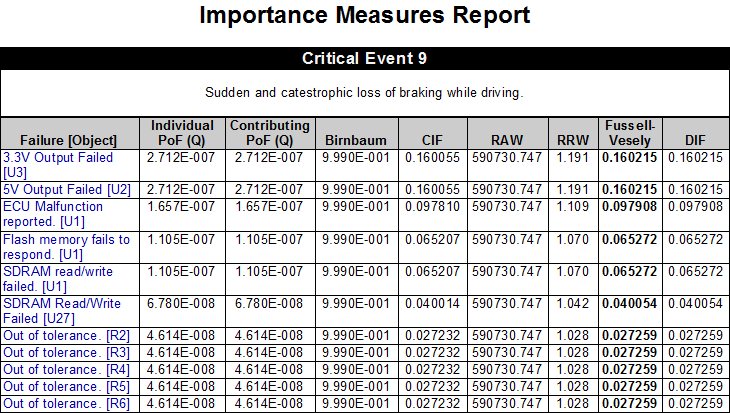

Products
Importance Measures Report
The Importance Measures Report lists standard industry measures of the importance of various elements to the successful performance of a given device or system. These metrics (some of which are shown at right) are staples of Probabilistic Risk and Safety Assessments (PRA & PSA).
This report includes, when required, detailed descriptions of each metric and the value in the analysis.

Metric Descriptions
Individual PoF (Q) – Individual Probability of Failure
The Individual Probability of Failure represents the likelihood that a particular element will fail within the specified exposure time.
This metric is useful for identifying the elements that are most likely to fail.
Contributing PoF (Q) – Contributing Probability of Failure
The Contributing Probability of Failure is the portion of a particular element’s Individual Probability of Failure that is included in the overall probability of critical failure.
This metric is useful for identifying the elements that, when they fail, are most likely to result in a critical failure.
Birnbaum – Birnbaum Importance Measure
The Birnbaum Importance Measure (sometimes called Marginal Importance Factor) represents the degree to which changes to a particular element’s reliability impact the overall probability of critical failure.
This metric is useful for identifying elements that are system-critical because they partially mitigate (are in the same minimal cut sets as) other, relatively likely failures.
CIF – Critical Importance Factor
The Critical Importance Factor represents the expected degree to which a particular failure will impact the overall probability of critical failure.
This metric is useful for identifying elements which should be treated as a priority for maintenance both due to their own unreliability and because they partially mitigate (are in the same minimal cut sets as) other, relatively likely failures.
RAW – Risk Achievement Worth
The Risk Achievement Worth (sometimes called Risk Increase Factor) represents how much the probability of critical failure increases when a particular element fails.
This metric is useful for identifying elements that should be prevented from failing using prognostics, planned maintenance or some other failure avoidance method.
RRW – Risk Reduction Worth
The Risk Reduction Worth (sometimes called Risk Decrease Factor) represents how much the probability of critical failure decreases when it is presumed that a particular element will not fail.
This metric is useful for identifying areas of the design that, if they were either improved or maintained aggressively, would result in the greatest reduction of risk.
Fussell-Vesely – Fussell-Vesely Importance Measure
The Fussell-Vesely Importance Measure is the probability, given that a critical failure has occurred, that at least one minimal cut set containing a particular element contributed to that failure.
Because this metric identifies the failures that most likely will lead to a critical failure, it is often used for the selection of candidates for improvement.
DIF – Diagnostic Importance Factor
The Diagnostic Importance Factor (DIF) is the probability, given that a critical failure has occurred, that a particular element has failed.
This metric can be useful when prioritizing diagnostic activities.


